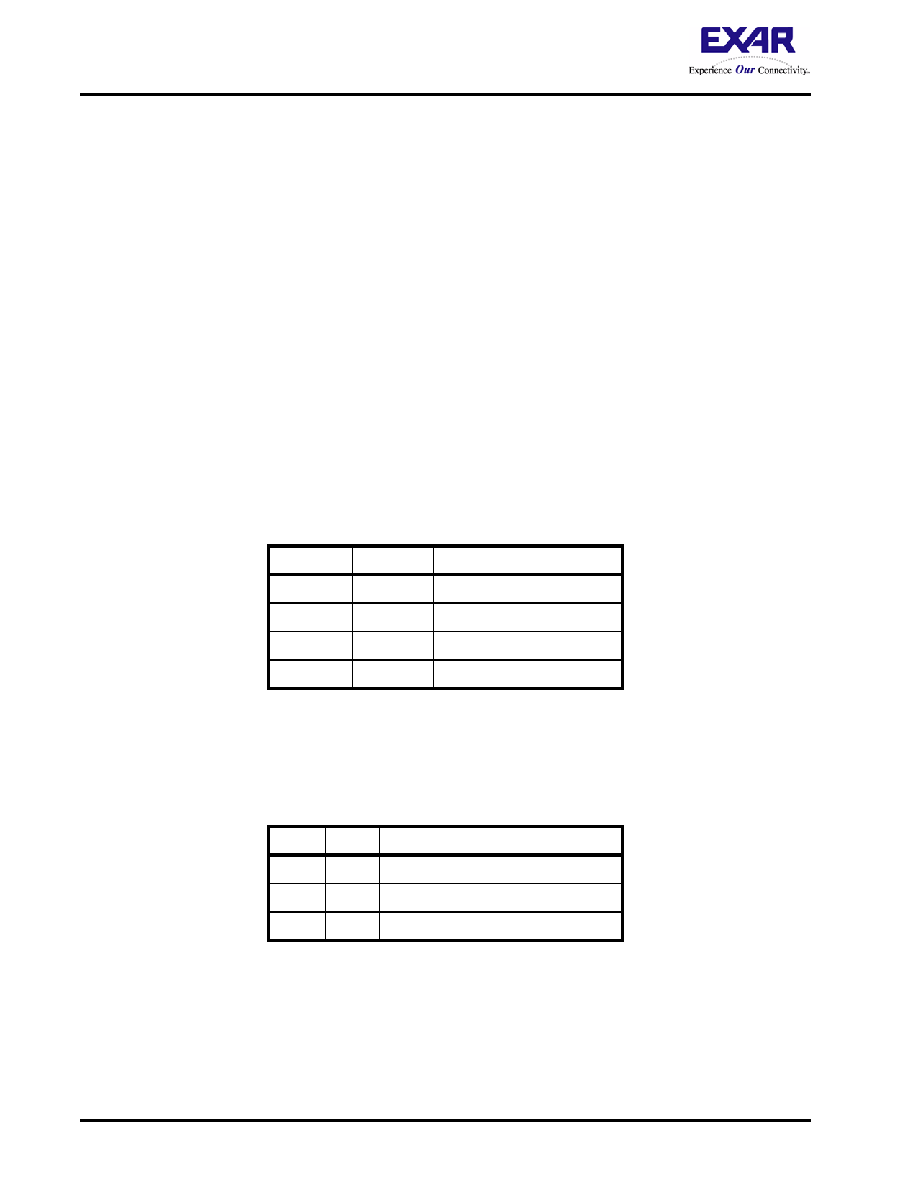- 您現(xiàn)在的位置:買賣IC網(wǎng) > PDF目錄16512 > XR19L212IL48-0B-EB (Exar Corporation)EVAL BOARD FOR XR19L202 48QFN PDF資料下載
參數(shù)資料
| 型號: | XR19L212IL48-0B-EB |
| 廠商: | Exar Corporation |
| 文件頁數(shù): | 51/52頁 |
| 文件大小: | 0K |
| 描述: | EVAL BOARD FOR XR19L202 48QFN |
| 標(biāo)準(zhǔn)包裝: | 1 |
| 系列: | * |
第1頁第2頁第3頁第4頁第5頁第6頁第7頁第8頁第9頁第10頁第11頁第12頁第13頁第14頁第15頁第16頁第17頁第18頁第19頁第20頁第21頁第22頁第23頁第24頁第25頁第26頁第27頁第28頁第29頁第30頁第31頁第32頁第33頁第34頁第35頁第36頁第37頁第38頁第39頁第40頁第41頁第42頁第43頁第44頁第45頁第46頁第47頁第48頁第49頁第50頁當(dāng)前第51頁第52頁

XR19L212
8
TWO CHANNEL INTEGRATED UART AND RS-232 TRANSCEIVER
REV. 1.0.1
2.2
5-Volt Tolerant Inputs
The CMOS/TTL level inputs of the L212 can accept up to 5V inputs when operating at 3.3V. Note that the
XTAL1 pin is not 5V tolerant when an external clock supply is used.
2.3
Device Hardware Reset
The RESET or RESET# input resets the internal registers and the serial interface outputs in both channels to
their default state (see Table 16). An active pulse of longer than 40 ns duration will be required to activate the
reset function in the device.
2.4
Device Identification and Revision
The XR19L212 provides a Device Identification code and a Device Revision code to distinguish the part from
other devices and revisions. To read the identification code from the part, it is required to set the baud rate
generator registers DLL and DLM both to 0x00. Now reading the content of the DLM will provide 0x01 and
reading the content of DLL will provide the revision of the part; for example, a reading of 0x01 means revision
A.
2.5
Channel A and B Selection
The XR19L212 provides the user with the capability to bi-directionally transfer information between an external
CPU and an external serial communication device. During Intel Bus Mode (I/M# pin connected to VCC), a
LOW on chip select pins, CSA# or CSB#, allows the user to select UART channel A or B to configure, send
transmit data and/or unload receive data to/from the UART. Selecting both UARTs can be useful during power
up initialization to write to the same internal registers, but do not attempt to read from both UARTs
simultaneously. Individual channel select functions are shown in Table 1.
During Motorola Bus Mode (I/M# pin connected to GND), the package interface pins are configured for
connection with Motorola and other popular microprocessor bus types. In this mode the XR19L212 decodes an
additional address, A3, to select one of the UART ports. The A3 address decode function is used only when in
the Motorola Bus Mode. See Table 2.
2.6
Channel A and B Internal Registers
Each UART channel in the L212 has a set of enhanced registers for control, monitoring and data loading and
unloading. The configuration register set is compatible to those already available in the standard single
16C550 and dual ST16C2550. These registers function as data holding registers (THR/RHR), interrupt status
and control registers (ISR/IER), a FIFO control register (FCR), receive line status and control registers (LSR/
LCR), modem status and control registers (MSR/MCR), programmable data rate (clock) divisor registers (DLL/
DLM), and an user accessible Scratchpad register (SPR).
TABLE 1: CHANNEL A AND B SELECT IN 16 MODE
CSA#
CSB#
FUNCTION
1
UART de-selected
0
1
Channel A selected
1
0
Channel B selected
0
Channel A and B selected
TABLE 2: CHANNEL A AND B SELECT IN 68 MODE
CS#
A3
FUNCTION
1
N/A
UART de-selected
0
Channel A selected
0
1
Channel B selected
相關(guān)PDF資料 |
PDF描述 |
|---|---|
| VI-25M-EX | CONVERTER MOD DC/DC 10V 75W |
| A3BKB-1018G | IDC CABLE- ASR10B/AE10G/APK10B |
| VI-JVT-EZ-S | CONVERTER MOD DC/DC 6.5V 25W |
| UPJ1K470MPD6TD | CAP ALUM 47UF 80V 20% RADIAL |
| H3WWH-2406G | IDC CABLE - HPL24H/AE24G/HPL24H |
相關(guān)代理商/技術(shù)參數(shù) |
參數(shù)描述 |
|---|---|
| XR19L212IL48-F | 功能描述:UART 接口集成電路 UART RoHS:否 制造商:Texas Instruments 通道數(shù)量:2 數(shù)據(jù)速率:3 Mbps 電源電壓-最大:3.6 V 電源電壓-最小:2.7 V 電源電流:20 mA 最大工作溫度:+ 85 C 最小工作溫度:- 40 C 封裝 / 箱體:LQFP-48 封裝:Reel |
| XR19L212IL48TR-F | 制造商:Exar Corporation 功能描述:UART 2-CH 64Byte FIFO 5V 48-Pin QFN EP T/R 制造商:Exar Corporation 功能描述:XR19L212IL48TR-F |
| XR19L220 | 制造商:EXAR 制造商全稱:EXAR 功能描述:SINGLE CHANNEL INTEGRATED UART AND RS-232 TRANSCEIVER |
| XR19L220_07 | 制造商:EXAR 制造商全稱:EXAR 功能描述:SINGLE CHANNEL INTEGRATED UART AND RS-232 TRANSCEIVER |
| XR19L220IL40 | 制造商:EXAR 制造商全稱:EXAR 功能描述:SINGLE CHANNEL INTEGRATED UART AND RS-232 TRANSCEIVER |
發(fā)布緊急采購,3分鐘左右您將得到回復(fù)。